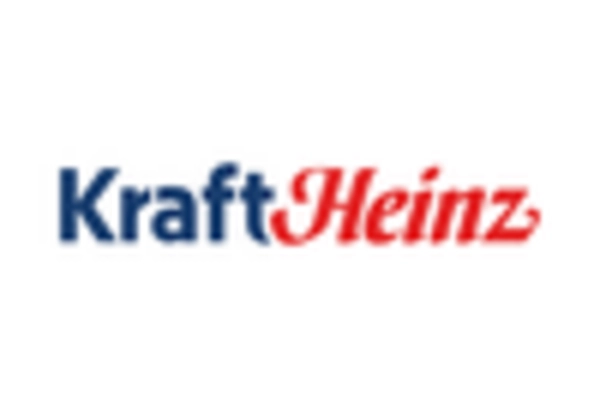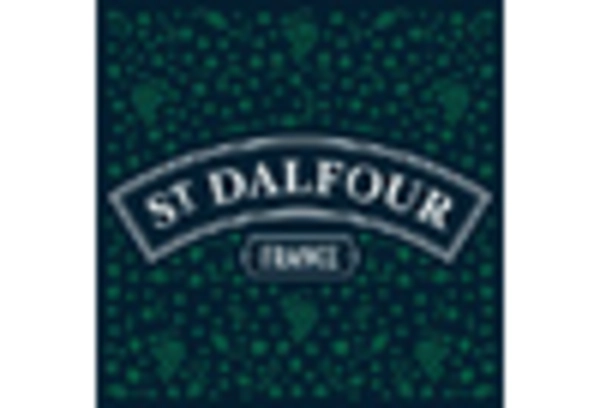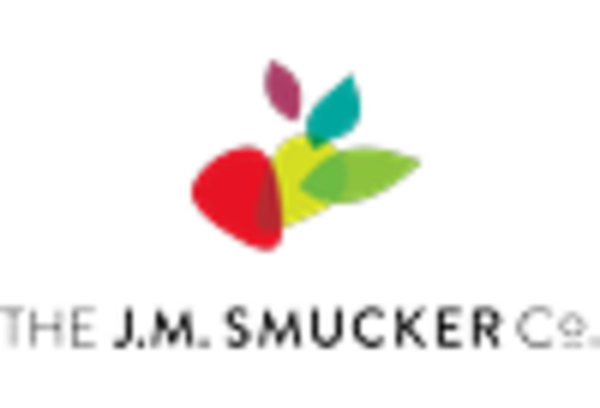Emergence of Unique Flavor Profiles
The fruit spreads market is evolving with the introduction of unique and exotic flavor profiles. Consumers are increasingly adventurous in their culinary choices, seeking out innovative combinations that go beyond traditional fruit flavors. This trend is reflected in the growing popularity of spreads featuring ingredients such as superfoods, spices, and even savory elements. Market Research Future indicates that products with unique flavor offerings are experiencing a growth rate of around 10% annually, suggesting a strong consumer appetite for variety. Brands that successfully leverage this trend by creating distinctive flavor profiles are likely to differentiate themselves in the competitive landscape of the fruit spreads market.
Increased Focus on Breakfast Options
The fruit spreads market is witnessing a resurgence in breakfast consumption, with fruit spreads being a staple choice for many consumers. As breakfast is often considered the most important meal of the day, there is a growing trend towards enhancing breakfast experiences with flavorful and nutritious spreads. Data indicates that approximately 60% of consumers regularly include fruit spreads in their breakfast routines, whether on toast, pancakes, or as part of smoothies. This trend is further fueled by the rise of brunch culture and the increasing popularity of artisanal breakfast items. Consequently, brands that position their products as essential breakfast companions are likely to capture a larger share of the fruit spreads market.
Convenience and On-the-Go Consumption
The fast-paced lifestyle of consumers in the US is significantly influencing the fruit spreads market. There is a growing preference for convenient, ready-to-eat products that can be easily incorporated into busy schedules. Single-serve packaging and portable options are becoming increasingly popular, catering to consumers who seek quick and hassle-free meal solutions. This trend is particularly evident among younger demographics, who prioritize convenience without compromising on taste or quality. Market analysis suggests that single-serve fruit spreads are projected to account for over 20% of total sales in the coming years. As such, brands that innovate in packaging and product formats are likely to thrive in the competitive landscape of the fruit spreads market.
Rising Demand for Natural Ingredients
The fruit spreads market is experiencing a notable shift towards natural and organic ingredients. Consumers are increasingly seeking products that are free from artificial additives and preservatives. This trend is driven by a growing awareness of health and wellness, with many individuals opting for spreads that contain minimal processing. According to recent data, the organic fruit spread segment has seen a growth rate of approximately 15% annually, indicating a strong consumer preference for natural options. This demand for clean-label products is reshaping the fruit spreads market, as manufacturers adapt their offerings to meet these evolving consumer expectations. As a result, brands that emphasize transparency in sourcing and production are likely to gain a competitive edge in the fruit spreads market.
Growing Interest in Local and Artisanal Products
The fruit spreads market is benefiting from a rising interest in local and artisanal products. Consumers are increasingly inclined to support small-scale producers and seek out spreads that reflect regional flavors and traditional methods. This trend is driven by a desire for authenticity and a connection to local food systems. Data shows that sales of artisanal fruit spreads have increased by approximately 12% over the past year, highlighting the potential for growth in this segment. Brands that emphasize their local sourcing and craftsmanship are likely to resonate with consumers, thereby enhancing their market presence in the fruit spreads market.

















Leave a Comment